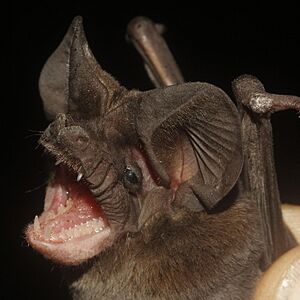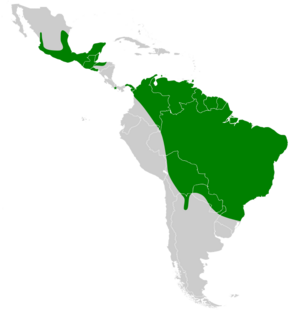Broad-eared bat facts for kids
Quick facts for kids Broad-eared bat |
|
|---|---|
 |
|
| Conservation status | |
| Scientific classification | |
| Genus: |
Nyctinomops
|
| Species: |
laticaudatus
|
 |
|
| Synonyms | |
|
Tadarida laticaudata |
|
The broad-eared bat, also called the broad-tailed bat, is a type of free-tailed bat. Its scientific name is Nyctinomops laticaudatus. These bats live in North and South America.
Contents
What Does the Broad-Eared Bat Look Like?
The broad-eared bat is a small bat. It is about 10 cm (3.9 in) long. That's about the length of a pen! It weighs around 11 g (0.39 oz), which is like weighing a few quarters.
These bats have a dark chocolate brown body. Their bellies are a bit lighter in color. Their wings are thin and clear, without much hair. The bat's nose is pointy and turns up at the end. Its lower jaw is longer and thinner than other free-tailed bats. As its name suggests, this bat has very wide, round ears. These ears even join together in the middle of its forehead!
Where Do Broad-Eared Bats Live?
Broad-eared bats live in warm, wet forests. You can find them from the coast of Mexico all the way down to southern Brazil. They live in many different types of forests. They can also be found in scrubland and even in cities!
These bats live from flat coastal areas up to cloud forests. Some live as high as 1,500 m (4,900 ft) (about 4,900 feet) above sea level. But they are more common below 500 m (1,600 ft) (about 1,600 feet).
Scientists have found five different groups, or subspecies, of broad-eared bats:
- N. l. laticaudatus lives in southern Paraguay and nearby parts of Brazil and Argentina.
- N. l. europs lives in South America, east of the Andes mountains. This includes places from Venezuela to northern Paraguay and Argentina.
- N. l. ferrugineus lives along the coasts of central and northeastern Mexico.
- N. l. macarenensis lives in South America, west of the Andes. This area stretches from western Venezuela to northern Peru.
- N. l. yucatanicus lives in Central America, southern Mexico, and Cuba.
How Do Broad-Eared Bats Live?
Broad-eared bats are active at night. During the day, they rest in rocky cracks. They live in large groups, called colonies. These groups can have anywhere from 150 to 1,000 bats! Some colonies in Tamaulipas, Mexico, have even had thousands of bats living in caves.
These colonies might stay in one place all year. But sometimes, bats will move to different roosting spots. Individual bats don't always return to the exact same home area.
What Do Broad-Eared Bats Eat?
Broad-eared bats are insectivores. This means they eat insects! Their favorite foods are beetles and moths.
Who Hunts Broad-Eared Bats?
Some animals hunt broad-eared bats. These predators include owls, sparrowhawks, and snakes that can climb trees.
Broad-Eared Bat Babies
Broad-eared bats have their babies during the rainy season. In the northern parts of their range, babies are born between June and July. Further south, they are born later in the year.
A mother bat usually gives birth to one baby at a time. The baby is born without hair and weighs about 3 g (0.11 oz). That's less than a penny! Baby bats open their eyes just a few hours after they are born.
See also
 In Spanish: Murciélago orejón para niños
In Spanish: Murciélago orejón para niños


